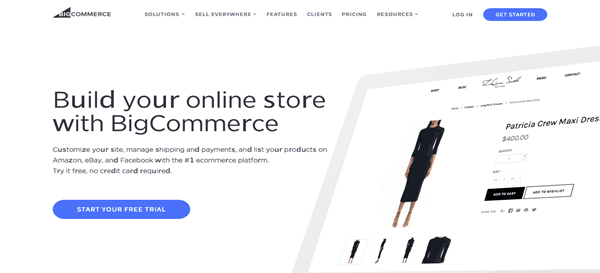
Increase in consumer preference for online shopping over traditional stores made businesses embrace internet marketing and eCommerce. With global eCommerce business market growing steadily each year, businesses big or small leverage eCommerce to reach new audience, beat the competition and create a new source of revenue.
But recent research also suggests about 80-95% of eCommerce business fail. Though it is easy to start selling online, managing a successful eCommerce store on a long run is difficult. Insufficient funds, poor website management and inefficient marketing strategies are some reasons to point out.
Many small businesses choose trail and error methods for selling online, but a well-articulated business plan can reduce the risk of failures and increase your return on investment.
So here is a guide on building a successful eCommerce store for your business from scratch. Start with –
- Understanding the basics of eCommerce models, then
- Select a product niche
- Register your business
- Setup an eCommerce store
- Attract customers to your site
- Device marketing strategies to improve sales and retain customers
Understanding the basics of eCommerce business models:
As a startup, it is easy to get carried away by the idea of Amazon and eBay to replicate their business model. But there isn’t a single business structure that suits everyone, every model is unique.
Small business owners with minimal investment may not have the leverage to set up a physical location to store their goods, in that case, you can opt for drop shipping model, where you can ship your product through a third-party vendor to your customers. There are tools and websites online to support the drop-ship model with supplier details. Oberlo is one such plug-in from Shopify.
But for unique product or service ideas, and without sufficient investment for manufacturing, choose custom manufacturing from third-party vendors, private labeling or white labeling methods, where you can get the product manufactured and labeled in your brand name before selling the product.
ECommerce Niche Selection:
Online tools like Google trends, keyword planners and forums like Quora and Reddit can give a broad idea on products and services in demand. Channelize these ideas to a particular niche; for example, mobile phones fall under the niche “electronics”,
Narrow down the niche to a particular product that provides true value to customers but still competitive in the market. For instance, “mobile accessories” is a micro niche in electronics. Selecting a specific Niche instead of selling random products will –
- Create a value proposition for your business.
- Increase demand and increase sale.
- Refine the radar of target audience.

Define the niche with your target audience and product pricing in mind.
Understanding Audience: Answering questions like – Who you are selling to? What does your store represent? Who are your ideal customers? Can help refine your product selection and create a visionary image of your target audience, which can also help with brand promotion in future.
Product Pricing: Look out for products with a considerable profit margin. Consider selling products with 35- 50% profit from the investment, meanwhile selling products that are way too costly like iPhones or laptops, you may have to set up a proper channel for the customers to communicate with you before making the purchase.
Passion: Finally follow your passion, even with a complete understanding of your niche market, but without your passion for the product, you may not be able to continue the business on a long-term.
eCommerce Business Registration:
After setting a plan for your business, register your business to comply with local and state laws on taxes, operation and naming, so you can work as a legitimate entity creating a strong foundation for your growth.
The process includes –
- Setting up a business name that helps customers find your business.
- Get your employer identification number to open a business bank account and to file taxes.
- Obtain needed business licenses and permits that abides with your city and state for operation.
Decide on the logo and visuals for branding and also create a database of resources and vendors before setting into building an eCommerce store.
eCommerce Store Development:
Setting up an eCommerce store involves –
- Registering your domain name.
- Designing and eCommerce web development.
- Setting an eCommerce platform, and
- Launching the site.
Check for available domain names on sites like GoDaddy.com; Domain.com that suits your business; design and develop a website with the help of tools like WordPress, Shopify or BigCommerce; or choose to get a customized website developed with in-house web developers, or you can also hire an eCommerce store development agency who can do the work for you.
Building your own eCommerce platform from scratch was a choice, but not a wise one for budding businesses. On the other hand, choosing the right eCommerce platform can be tricky too. Instead of choosing the best eCommerce platform based on popularity, choose the one that successfully delivers the outcomes and objectives that you have set for your business.
Choosing the right eCommerce Software:
Consider the following features while selecting the right eCommerce platform for your business –
- The availability of features and functionality you needed for your website.
- Compatibility with different payment gateways and a secure checkout system.
- Compatibility with your business structure and adapting to the competitive landscape.
- Your web development and technical skills.
- SEO friendly features; offering compatibility across devices.
- A solid backend support system.
Commercial eCommerce platforms either give you the choice to design the software from scratch or provide the complete package at a prepaid cost.
If you have technical skills or a team of experts in-house, choose an open-source platform such as Magento, where you can customize your platform for your business needs but have to pay for eCommerce web development, implementation and upgrades.

SaaS eCommerce platforms like BigCommerce are easy to set up without technical expertise, they are feature-loaded and readily scalable, but the only drawback is that the monthly subscription is steep.

Shopify is also feature-loaded, scalable, with numerous templates to design your website, but not considered SEO friendly.

For a small business with simple product ideas, keep your platform simple with minimal needed features. So, try purchasing a platform that is –
- Less time-consuming.
- Cost-effective.
- Without complicated transactions, and
- Customized backend features.
Well-experienced eCommerce web development company can also help to find the right tool based on your business needs.
Selling in a Marketplace:
Alternatively, with a small investment, start selling your product on online marketplaces like Amazon FBA and websites in your location that suits your niche. A marketplace is large with a huge target market that you can kick-start your sales right away but at the cost of sharing your profit and complete control over your business.
Combine both strategies: Try selling in the marketplace to test the sales, while setting up an online store to create a long-lasting brand.
Attracting Customers to your site:
Once the eCommerce site is launched, it’s time to invite customers to your store. Unlike a physical store, you cannot sit back and relax to let your first customer land on your website. Your website has to be on top of the Google search results when your audience are searching for your product or service.
Optimize the site for search engines and create content with user intent.
Keywords Matter: Every product page and URLs must be optimized with the relevant keywords and content with audience search intent in mind. You can use online analysis tools like Google keyword planner; Ahrefs or SEMrush to refine your keyword list and understand your competitors. Niche-specific brands can leverage the use of long-tail keywords for their products that can yield a highly-targeted audience compared to irrelevant traffic.
Optimize the website for both onsite and offsite SEO and run a technical SEO audit regularly.
Use social media sites such as Facebook, Instagram and Twitter to post regular updates on your products and to communicate with your audience to create brand awareness.
While big brands can leverage the power of pay-per-click ads, startups can focus on cost-effective digital marketing methods like SEO, Social media marketing, content marketing and email marketing to increase website visits.
Increase Sales:
Most eCommerce marketing efforts are efficient in driving traffic to your website, but that is not the only objective – Your site has to be designed for sale, easy conversion. Create a website with a good user experience to increase purchase. Design –
- Easy navigation between pages.
- Quick checkout process.
- Informative product descriptions in simple language.
- Chat and email support system for easy communication.
Use analytics tools like Google analytics, Ahref, Buzzsumo, SEMrush and Moz.com for analyzing your marketing efforts, understanding your competitors and writing better content on your website.
Email Marketing for eCommerce Business:
Email marketing is the key to excel in the eCommerce market. Leverage the power of emails to communicate consistently with your audience to address their queries and to give updates on product and shipment.
Create a customer email list: Create email marketing campaigns with discounts and giveaways for subscriptions to increase your brand presence, drive traffic to your website, and retain customers in the long run.
Ready to start?
A channelized and consistent approach in marketing is the strategy to sustain in the online business industry. But, for small businesses the lack of time, resource and technical skillset can prove to be never-ending hurdles for success.
So, it’s always a good idea to get some help from experts in the industry for solid backend support. Our team of industry experts in eCommerce Outsourcing Services can connect with you for further understanding of your business model and provide the needed support.
Also, feel free to include your ideas and queries about this blog in the comment section.
Interesting posts to read:








